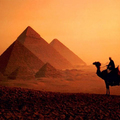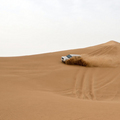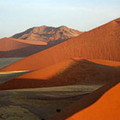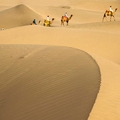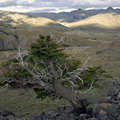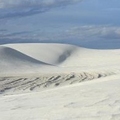Eco-friendly locations / The Largest Deserts in the World / The Thar Desert
The Thar Desert
The Thar Desert, also known as the Great Indian Desert , is a large, arid region in the north-west of the subcontinent of India . With an area of 200,000 square kilometers , the desert is the seventh in the world by extension. It is found mostly in the Indian state of Rajasthan , and extends in the southern states of India of Punjab , Haryana and north Gujarat. In Pakistan the desert covers the eastern region of the province of Sind and the southwestern part of Punjab . The Cholistan Desert adjoins the Thar desert, always in the Pakistani province of Punjab. The Thar is bordered to the north-west by the river Sutlej , on the east by the Aravalli Mountains , on the south by the salt marsh known as the Rann of Kutch (sometimes included in the Thar), and on the west by the river Indus . Its northern limit is not well defined, depending on the regions to the north dug included or excluded. The nominal size of the Thar can vary significantly.
The origin of the Thar Desert
The origin of the Thar is a controversial topic. Some believe that this took place between 4,000 and 10,000 years ago, while others state that aridity started in this region much earlier. Another theory states that the process of desertification is relatively recent, perhaps between 2,000 and 1,500 BC. Around this time the Ghaggar ceased to be a great river. Now the river ends in the desert. It has been observed through remote sensing techniques (on the paleo-channels) that climate changed during the late Quaternary which played a significant role in changing the availability of water and the shape of the river basins of the region. The majority of studies argue that the paleo-channel of Sarasvati coincides with the bed of today's Ghaggar and believe that the Sutlej along with the Yamuna once flowed into the Ghaggar basin. Probably the Sutlej was the main tributary of the Ghaggar, and subsequently the tectonic movements might have forced the Sutlej flowing westward, and the Yamuna to the east, draining the river Ghaggar in fact. Presumably tar got its name from the word Tahl, which in local dialect means the ridge of sand dunes.
Description
In spite of the harsh climate, still, the Thar desert is not an endless sea of sand, devoid of life and wildlife. This is a living and dynamic eco-system, which is one of the most populous deserts in the world. There are a large variety of wild animals and plants that can adapt to the harsh climatic and environmental conditions of their stay in the desert. Among mammals, there is the Indian gazelle (Gazella Gazella or chinkara), the Indian fox, the desert fox, the jackal, the desert cat, the jungle cat and the nilgai, which are widely distributed in the wilderness, the Indian government eponymous national park. Much unsettled areas provide favorable conditions for the survival of many species of lizards, snakes and small mammals such as rats desert gerbils. Lizards with spiny-tailed prehistoric appearance, are quite common in many areas of the park. Among the most frequent is the snake viper, the rat snake and the sand boas. Most residents of the desert came up with their own survival because of the lack of water. They reduce physical activity during the hottest time of the day and hide from the hot winds, burying in the sand or hiding in the shadow of the few local plants. Despite the exorbitant temperature of the land surface, the animal is buried in the sand just a few inches below the surface to feel comfortably even on a hot day before the onset of cool nights. Living in a national park foxes, cats, lizards and snakes usually live in burrows, and the peak of their activity is in the early morning hours. In contrast to the small divotnyh, Gesell cannot hide from the heat, not in a burrow or under the shade of bushes, and they can withstand the temperature which rises of up to seven degrees above the normal, without any serious damage to vital organs. These animals can live without water for several days, feeding on succulent green plants such as Calotropics procera, growing in the desert, getting water from leaves. Plants in the desert use different strategies to survive in desert conditions. To reduce evaporation the leaves of these plants are reduced in size, as is the case khejri (Prosopis cinerara). Some species such as kair (Cappairs dedicua) and Phog (Calligonum polkygonides) do not grow, they develop only the stems that do the work of photosynthesis. Thanks to these stratagems perennials can withstand long periods of drought.
The Thar Desert is of great interest in geological and historical sense to the study of fossils. The sea was at least four times in the last two hundred eighty million years. It is believed that the desert is the place of the Triassic seas. The sea took twenty-five million years, leaving the sediment in the fossilized fragments of plants and animals that are found in the sediments of many areas. And again, after twenty-five million years it has become a sea. In the limestone and sandstone in Jaisalmer district fossils of ammonites preserved from that time were discovered. In the lower Cretaceous period, between 135 and 63 million years in the area grow wild lesa. It is considered that fossil plants Payvale (Paliwal), a village near Jaisalmer belong to this period. This was followed by another invasion of the sea and marine fossils were found in the rocks. At the end of the Cretaceous and early Cenozoic, sixty-three million years ago, the sea, seized these territories again. Remains of ancient sea creatures accumulated at the bottom and their slow decomposition is the main form of oil and natural gas in the Thar Desert. Petrified trees in the village Akal in the vicinity of Jaisalmer are the remnants of forests and ferns that flourished in the region in the early Jurassic period, about one hundred and eighty million years ago. Currently, about 25 petrified trunks of trees on the display in the park at Akal Fossil. The biggest tree is about seven feet long and five feet in circumference.
Others The Largest Deserts in the World .
Others from The Largest Deserts in the World
Under such dry conditions it is hard for the plants to live and the soils to form.
There is anything that protects the earth from overheating in these areas.
The hottest place on the Earth is the tropical desert, but there are coldest , even icy deserts, for instance, Antarctica.
Deserts cover approximately 20% of the Earth's land surface and 80% in Australia , therefore, a fifth of the Earth's land area belongs to the deserts.
Many of the major deserts are located near the tropics, such as the Sahara desert which is the largest desert in the world, as well as the Kalahari, the Namib Desert and the Grand Victoria in Australia.
Droughts During the grazing of cattle during droughts disorders of vegetation occur.
They are so significant that are likely unrecovered.
The sun's rays quickly dry the soil and turn to dust, which happens to desertification, a continuous transformation of the land in the desert.
A desert with a change in climatic conditions can always shrink and expand.
The long-term global climate change or contraction of the continents can garden the desert or turn it into a magnificent forest.
Short-lived changes in weather conditions influence the expansion of its borders, turning occasionally green areas in arid deserts.
The hottest places on the Earth are the tropical desert, where the daytime temperatures often reach +50 ° C.
This heat can destroy the stones and give the landscape an unusual character.
The underground water evaporates so quickly that minerals are dissolved from the crust.
Deserts are constantly dry, but in other natural areas prolonged dry periods can occur - the droughts.
Their presence in any place depends on what kind of rainfall is there.
There was a drought in Sahel, Africa, that lasted many months without rain.
However, droughts are regular and in some places they are with a typical moisture content, such as the North American grasslands which dry up every 22 years.
Water plays a significant role in shaping the dry landscape, despite of its low quantity in the desert .
Water alters the chemical composition of rocks, now and then it is dumped in the desert from the sky, at times becoming the cause of short, but strong flash floods, which are harmful to the soil.
Do all the deserts have very high temperatures and a lot of sand? We call a desert an area where not more than 25 inches of rain falls per year.
As a rule, deserts are formed in the hot desert climates, but there are exceptions.
Most deserts have a lot of rocks and stones and sand.
What is the biggest desert? The most extensive deserts are located in areas of high atmospheric pressures.
All the winds blow in areas of their inner regions, but the moist winds from the sea reach them very rarely.
There are those deserts, which are near the sea, and yet the sea winds will reach them, they lose most of moisture on the way.
Certain deserts are formed on the internal continental slopes of mountain ranges, well sheltered from the sea winds.
Almost all of Antarctica is a huge frozen desert, which is located in an area of high pressure, so that its interior is extremely small drops of fresh snow.
The driest desert in the world.
In many deserts there is no rain for several years in a row, then a short downpour happens and everything starts all over again.
The most arid desert is the Atacama Desert in South America .
Until 1971, there were 400 years without spilling a drop.
It is known that in several places in the desert, there are artesian waters, but the high boron content makes them unsuitable for irrigation.
What is an oasis? An oasis is a plot of land in the desert, which is covered with vegetation.
It feeds from underground springs or natural wells.
The largest desert in the world The largest desert in the world is the Sahara Desert in North Africa.
Its area is of approximately 8400 sq.
km.
However, only ten percent of its territory is covered with sand, and everything else is taken by bare rocks and stones.
After Sahara, we have the Arabian desert, the Gobi, the Patagonian,the Rub’ al Khali, the Great Victoria, the Kalahari, the Great Basin, the Chihuahuan and the Thar.

